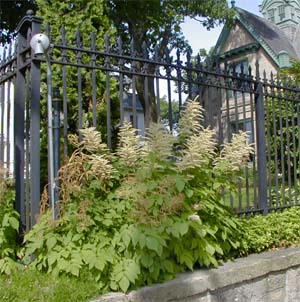
Goatsbeard, Aruncus dioicus, is a North American perennial with feathery plumes of cream colored flowers in late spring or summer. The arching plumes are densely covered with many small florets in 20-inch branched clusters, and resemble a large, airy Astilbe (to which goatsbeard is unrelated; Astilbe is in the saxifrage family while Aruncus is in the family Rosaceae). The plants are dioecious (separate male and female plants) and male plants supposedly have showier flowers than female ones. Plants are never identified as one or the other when offered for sale.
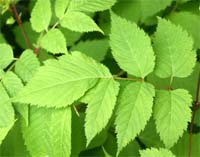
The flowers – which make good cut flowers – are at their peak for about 10 days. Female plants produce tiny brown seed capsules, which are poisonous. After flowering the plumes turn tan or light brown above the 3-4 foot mounds of dark green, pinnately compound leaves. Each leaf has 20 or more toothed oval leaflets. This clump-forming woodland plant is hardy in zones 3-8.
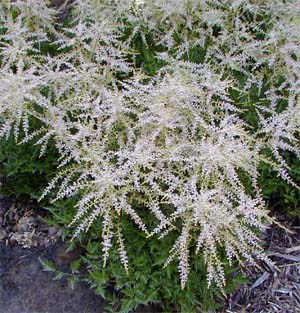
Aruncus is native to deciduous woodlands of eastern and central US as well as western Europe. The species is often divided into four naturally-occurring varieties. Aruncus dioicus var. dioicus occurs from Pennsylvania to Indiana, south to Arkansas and Alabama; Aruncus dioicus var. pubescens is found in the middle of the eastern US, from Virginia to Oklahoma, and Arkansas to Illinois; while Aruncus dioicus var. acuminatus is native to the western US. Aruncus dioicus var. vulgaris is from western and central Europe, Russia, and the Caucasus. There are few named cultivars; ‘Kneiffii’ is a more compact type (about 3 feet tall) with finely divided foliage, but less showy flowers. The German hybrid ‘Zweiweltenkind’ (‘Child of Two Worlds’) is shorter and sturdier than the species (3-4 feet tall), so does well in windy areas.

‘Glasnevin’ is a compact selection from the National Botanic Garden of Ireland that bears its name. The similar dwarf or Korean goatsbeard (Aruncus aethusifolius) grows only 8 to 12 inches tall and is hardy in zones 4-7. ‘Hillside Gem’ has more finely divided leaves.
Native Americans used the different parts of the plant medicinally.
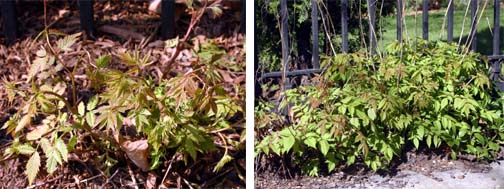
Goatsbeard grows best in moist, rich soil in partial shade, although it will do fine in full sun if given consistent moisture. Amend the soil with generous amounts of organic matter before planting. Space plants 2-4 feet apart, providing plenty of room to accommodate their mature size – once established, transplanting this species is a very difficult task. They tend to grow slowly the first few seasons. The wide-open spaces between young plants can be filled with annuals until the goatsbeard reaches its mature size.
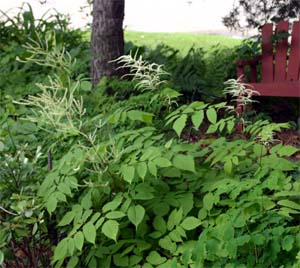
They combine well with Astilbe, monkshood (Aconitum), columbine and ferns in woodland gardens. Other native woodland wildflowers to plant goatsbeard with include wild ginger (Asarum), Virginia bluebells (Mertensia), Jacob’s ladder (Polemonium), bloodroot (Sanguinaria), wild Geranium and Trillium. This bold accent plant can be used as a specimen, as a large, almost shrub-like background plant in a perennial border, or for softening the transition at the edge of landscaped areas to woodlands. Use in small groups at the edge of a woodland path or mix with iris and ground covers in lightly shaded area. Goatsbeard is a natural beside a pool or stream in sun or shade. If space is limited, consider one of the smaller cultivars or dwarf goatsbeard. Dwarf goatsbeard is also suitable for use in rock gardens or near the front of flower borders.
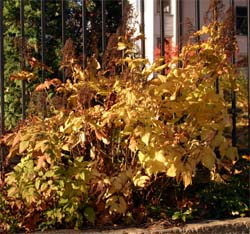
This low maintenance plant needs little care other than watering when the soil becomes dry. Cut back the stems back to just above ground-level in fall and apply a mulch of compost or well-rotted manure around the base of the plant (or in a woodland, allow the tree leaves to remain on the ground to decompose). Goatsbeard has no significant insect or disease problems and is reported to be deer resistant.
Propagate by division or grow from seed. To divide these rhizomatous plants, lift clumps in spring and cut the heavy rootstock with a sharp knife, leaving at least one eye per division. Fresh seed sown as soon as it is harvested on the surface of a warm seedbed should germinate in 2 to 3 weeks. Although goatsbeard self-seeds readily in the wild, it may be difficult to germinate in cultivation without stratification.
– Susan Mahr, University of Wisconsin – Madison
Ask Your Gardening Question
If you’re unable to find the information you need, please submit your gardening question here:





 ▶︎ Watch: Hydrangeas: Know Them and Grow Them
▶︎ Watch: Hydrangeas: Know Them and Grow Them ▶︎ Watch: Fall Bulb Planting
▶︎ Watch: Fall Bulb Planting Aster, Symphyotrichum spp.
Aster, Symphyotrichum spp. Fascinating Fasciation
Fascinating Fasciation


